Journal of Southeast Asian Economies Vol. 31/3 (Dec 2014)
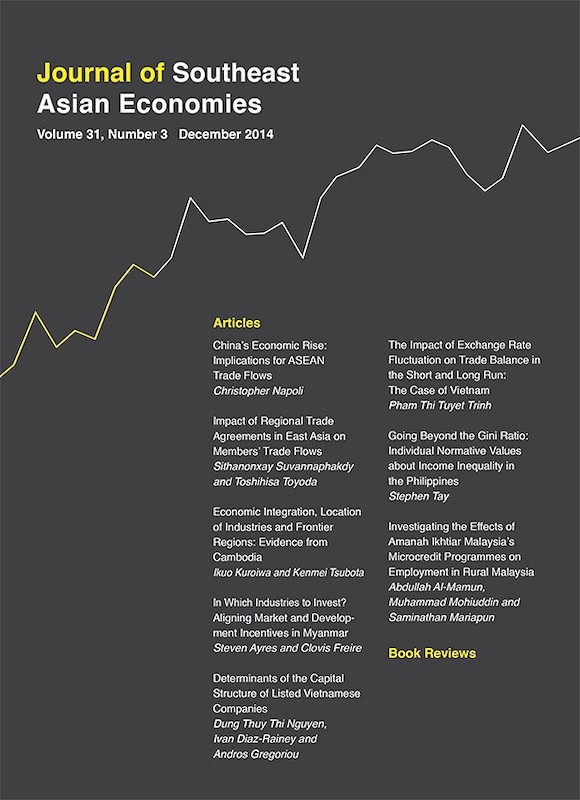
Date of publication:
December 2014
Publisher:
Institute of Southeast Asian Studies
Number of pages:
148
Code:
AE31/3
Contents
-
Journal of Southeast Asian Economies Vol. 31/3 (Dec 2014)
[Whole Publication] -
Preliminary pages
- ARTICLES
-
China's Economic Rise: Implications for ASEAN Trade Flows , by Christopher Cabuay, author see abstractThis paper evaluates the debate over whether China’s emergence as an economic superpower has been a complement or threat to ASEAN by examining data in the eleven years following China’s accession to the WTO. Employing a qualitative approach, it seeks to understand whether China’s growing dominance has hindered ASEAN GDP growth, exports and attractiveness as a destination for FDI. The evidence suggests that China’s rise has caused a shift in global trade patterns, with China dominating Western markets at the expense of ASEAN countries. Despite this, China’s dominance does not appear to have had a significant<br>negative effect on growth rates for ASEAN GDP, exports, or FDI stocks. Given this, the paper concludes that while China is crowding ASEAN out of Western markets, increased Chinese demand for ASEAN imports has more than offset this effect. The result is that ASEAN exports and GDP have grown despite shifting trade patterns in the short run.
-
Impact of Regional Trade Agreements in East Asia on Members' Trade Flows , by Sithanonxay Suvannaphakdy, Toshihisa Toyoda, authors see abstractUsing an unbalanced panel dataset of bilateral trade flows, we study the determinants of two-way trade for Australia, China, India, Japan, New Zealand, Korea and the ten ASEAN countries from 1990 to 2009. We find that bilateral trade flow is positively related to the sum of the GDP of trading countries, and similarity in GDP size, but inversely related to relative factor endowment differences, transportation costs and import tariffs. Our empirical results suggest that formulating an East Asian Free Trade Area is important for promoting intraregional trade. Furthermore, there is a need to provide a range of instruments to assist least-developed ASEAN countries in designing and implementing appropriate trade integration policies through the provision of technical and financial assistance as well as<br>analytical support.
-
Economic Integration, Location of Industries and Frontier Regions: Evidence from Cambodia , by Ikuo Kuroiwa, Kenmei Tsubota, authors see abstractThis paper examines changes in the location of economic activity in Cambodia between 1998 and 2008 in terms of employment growth. During this period, Cambodia joined ASEAN and increased trade with its neighbouring countries. Drawing on theoretical predictions made by New Economic Geography (NEG), we focus on frontier regions such as border areas and international port cities, and examine the changing state of manufacturing in Cambodia. Our results suggest that economic integration and concomitant trade linkages may lead to the industrial development of Cambodia’s frontier regions and metropolitan areas.
-
In Which Industries to Invest? Aligning Market and Development Incentives in Myanmar , by Steven Ayres, Clovis Freire, authors see abstractThis paper argues that fostering economic activity and facilitating investment in new and more productive industries will best advance inclusive economic growth in Myanmar. With a focus on the role of structural transformation, this paper presents a model describing how this can best be facilitated. We emphasize the use of strategies that push towards diversification, particularly in the direction of more productive economic activities. This paper also presents a methodology to identify diversification opportunities based on trade data.
-
Determinants of the Capital Structure of Listed Vietnamese Companies , by Dung Thuy Thi Nguyen, Ivan Diaz-Rainey, Andros Gregoriou, authors see abstractThis paper provides the first insights into the capital structure of listed companies in Vietnam, one of the most dynamic economies in the Asia-Pacific region. We employ a panel GMM (generalized method of moments) system estimator to analyse the determinants of the capital structure of non-financial firms listed on either the Ho Chi Minh Stock Exchange or the Hanoi Stock Exchange for the period 2007–11. We conclude that, despite the emergence in recent years of equity and a corporate debt capital market, the capital structure of Vietnamese enterprises is still dominated by the use of short-term financing sources. Further, our results show that state-controlled enterprises continue to have preferential access to finance and that high-growth firms still rely principally on external debt rather than equity issuance. These results indicate that policy-makers need to continue to pursue policies that will deepen capital markets and ensure that bank finance is allocated on a purely commercial basis.
-
The Impact of Exchange Rate Fluctuation on Trade Balance in the Short and Long Run: The Case of Vietnam , by Pham Thi Tuyet Trinh, author see abstractThis paper investigates the short- and long-run impact of the real exchange rate on trade balance in Vietnam from 2000 to 2010. The Autoregressive Distributed Lag (ARDL) method is used to explore the long-run impact, and a corresponding Error Correction Model (ECM) based on a long-run cointegration equation examines the impact on trade balance when a real depreciation of the VND has occurred. An Impulse response function based on the<br>ECM exhibits that trade balance takes on a J-curve pattern in the event of a permanent<br>depreciation.
-
Going Beyond the Gini Ratio: Individual Normative Values about Income Inequality in the Philippines, by Stephen Tay, author see abstractIncome inequality affects substantive outcomes such as redistribution and voter turnout. Nevertheless, a country’s level of income inequality has a differential impact on citizens’ evaluation of the same because individuals have different normative values about inequality. This paper shifts the analytical focus from objective income inequality—commonly measured by the Gini ratio—to subjective dimensions of income inequality, namely individual tolerance for income inequality. Using the Philippines as a case, this paper argues that a country’s level of objective income inequality does not systematically affect a person’s level of tolerance for<br>income inequality. This argument is counter-intuitive because most extant studies implicitly assume that a country’s level of income inequality affects a person’s values on the same. By focusing on a person’s redistributive preference, this paper also shows that subjective dimensions of income inequality can affect substantive outcomes.
-
Investigating the Effects of Amanah Ikhtiar Malaysia's Microcredit Programmes on Employment in Rural Malaysia, by Abdullah Al-Mamun, Muhammad Mohiuddin, Saminathan Mariapun, authors see abstractThe creation of either self-employment or wage-earning job opportunities is considered one of the more effective strategies for sustainable poverty alleviation. The Malaysian government promulgated a national plan for poverty eradication in its Vision 2020 agenda by emphasizing full employment. However, the classic trickle-down effects of large-scale industrialization policies can hardly be expected to reach the bottom-most tier of a country’s poorest group. Instead, more precise tools such as microcredit loans and socio-economic support services would better address hardcore poverty. This paper employs a cross-sectional design with<br>a stratified random sampling method to examine the impact of Amanah Ikhtiar Malaysia’s (AIM) microcredit programmes for women on employment generation at the client, household and community levels in rural Peninsular Malaysia
- BOOK REVIEWS
-
BOOK REVIEW: The Dynamics of Economic Growth: Policy Insights from Comparative Analyses in Asia, by Vu Minh Khuong, by Sasidaran Gopalan, Ramkishen S Rajan, authors
-
BOOK REVIEW: China and East Asia: After the Wall Street Crisis, edited by Lam Peng Er, Qin Yaqing and Yang Mu, by Catherine Rose James, author
-
BOOK REVIEW: The Trans-Pacific Partnership, China and India: Economic and Political Implications, by Amitendu Palit, by Malcolm Cook, author
-
BOOK REVIEW: Border Economies in the Greater Mekong Subregion, edited by Masami Ishida. , by Nathalie Fau, author
-
BOOK REVIEW: The Trans-Pacific Partnership: A Quest for a Twenty-first-Century Trade Agreement, edited by C.L. Lim, Deborah Kay Elms and Patrick Low, by Gloria O. Pasadilla, author


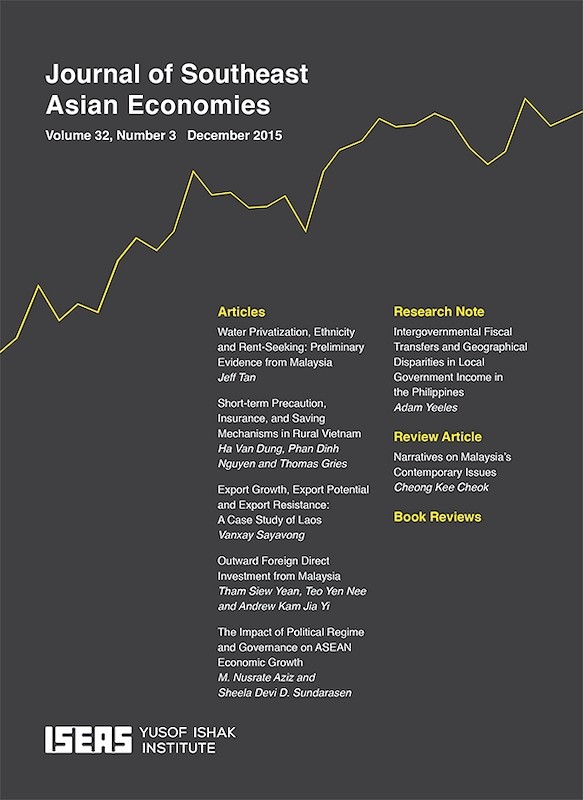
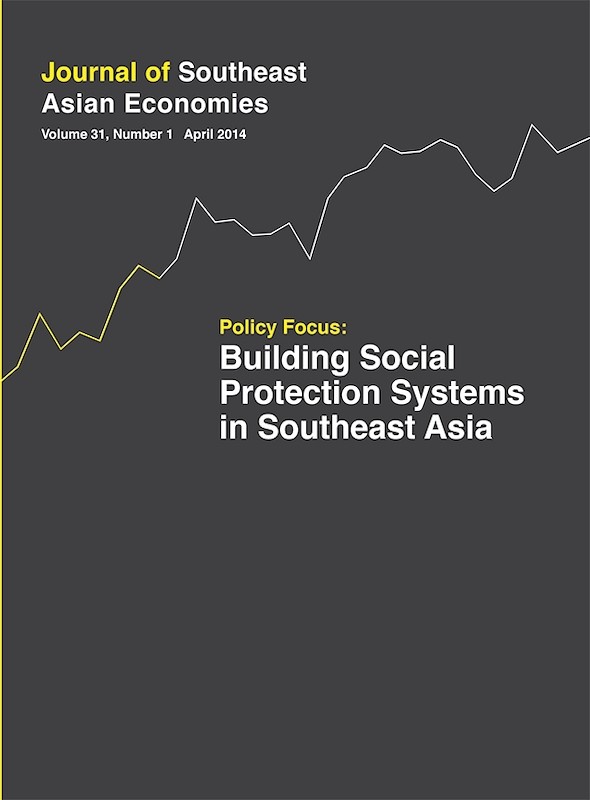
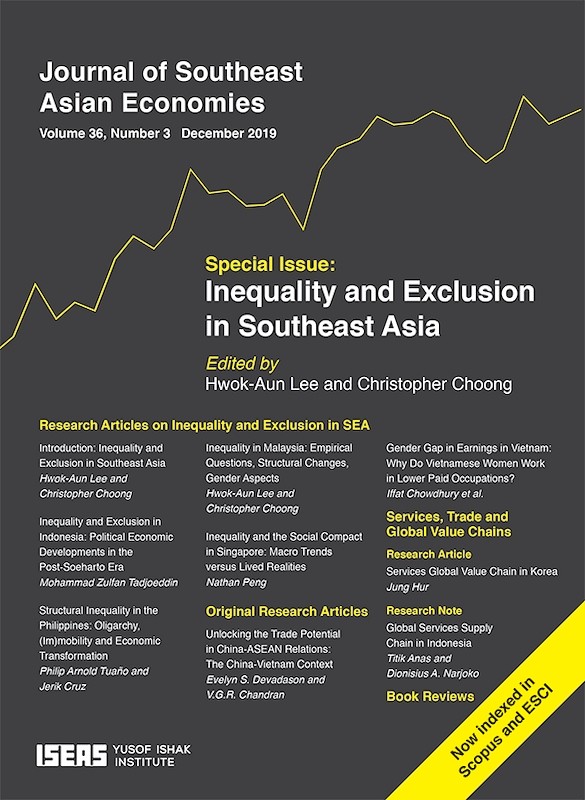
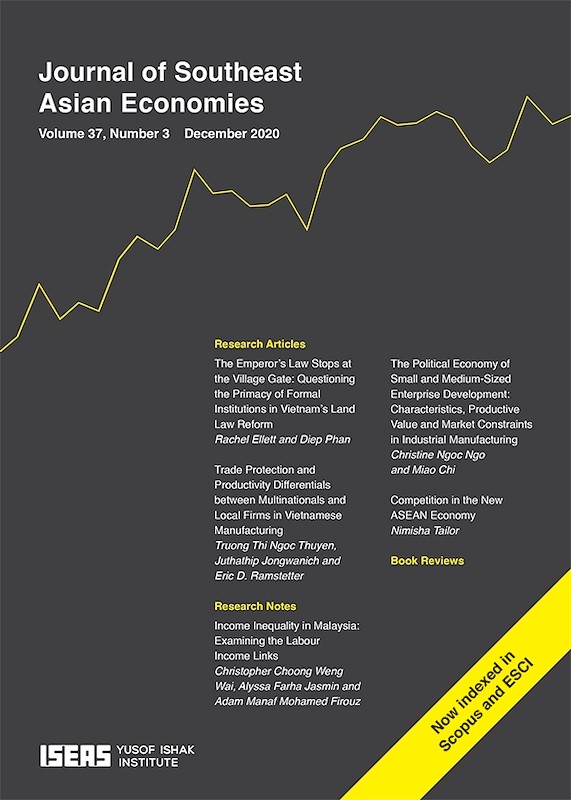
![Journal of Southeast Asian Economies Vol. 30/1 (Apr 2013) [formerly ASEAN Economic Bulletin]](/cover/AE30-1.jpg)